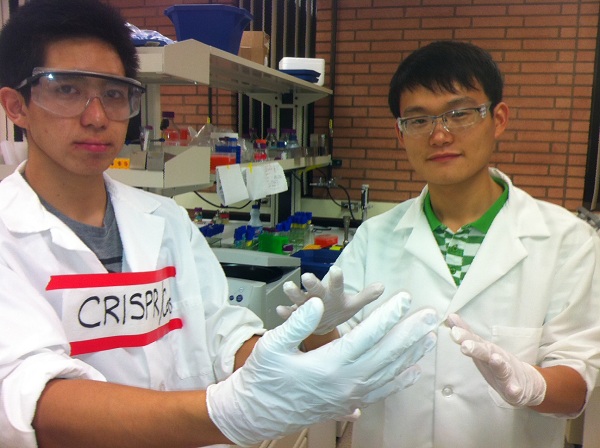Team:USC/Safety
From 2011.igem.org
 |
||
|
|
||
Biological Safety Concerns Regarding E. curiIdentifying Safety Issues in Our CRISPR ProjectWorking in a lab can be fun but also dangerous if safety for the student, society, and environment are not addressed. Therefore, the safety issues of these three important entities will be examined under the scope of risk assessment. To assess risk for a biological material many factors have to be considered, which include but are not limited to: the microbe's pathogenicity and ability to survive outside of the lab, public awareness of the biological agent, availability of a prophylaxis, environmental impact, and ability to monitor biological material that are potentially dangerous. We assess risk for the biological material involved in our project and its potential impact to the researchers, public society, and environment by taking into account two components of risk: probability and hazard. With probability, we ask ourselves:
Questions to consider about hazards associated with biological material risk are:
We assess biological safety risks with these questions in mind in an effort to make our project acceptably safe according to the standards set by organizations, such as the World Health Organization (WHO), the Convention on Biological Diversity, the National Institute of Health (NIH), American Biological Safety Association, Center for Disease Control, among other risk management groups, and conferences with an emphasis in synthetic biology and safety such as the SB5.0 conference. In addition, complying with these safety standards will make the project and its future directions more approachable for acceptance by the public society. Researcher SafetyEnsuring the safety of the USC iGEM lab and its researchers is critical to the success of the program. We have therefore taken initiative that each member understands and is aware of the following:
The laboratory, where the USC iGEM team works, is certified for Biosafety Level 1. Researchers are required to wear personal protective equipment (PPE) which include goggles, gloves, and lab coats so that the eyes, hands, and body, respectively, are always protected from possible exposure to a biological material. Potentially harmful biological materials and chemicals are used daily in the lab. Below is a description of each one we encounter on a daily or limited basis as well as the measures taken to comply with USC's stringent safety standards so that we maintain the highest quality of our safety:
To ensure the researchers of USC iGEM are acceptably safe from physical harm by biological material or chemical exposure, each team member attended a Safety Orientation Course conducted by USC's Career and Protective Services (CAPS). In addition, the protocols used in our project have been approved by the Institutional Biosafety Committee. Public SafetyAlthough the E. coli strains we are using are non-pathogenic, we remain aware that our project can potentially be a concern for public safety. By addressing this issue early, we lower the risk of fear and mistrust that can be met by the scrutiny of the general public when introducing a new biotechnological tool to the marketplace and diminish the uncalculated possibility of causing sever physical and non-physical harm. Our approach to public safety can be categorized as follows:
The USC iGEM lab is located within the USC campus, one that invites more than 30,000 students daily. In addition, the campus is located merely miles from Downtown Los Angeles and other neighboring cities where millions of people reside. The risk for infection from the bacteria we use is extremely low since we use strains that are engineered for laboratory experiments. These strains would be unable to survive in the outside environment. However, we still do the following to minimize this risk as much as we can:
These simple procedures are implemented to ensure that the public in our immediate surroundings is respected with our safety concerns for them. At first, it may seem difficult to judge the effect of our project on public safety on a national level. However, the CRISPR system in our model is designed to counteract potential spreading and resistance of harmful microbes. As such, our project may in fact increase public safety and health. Environmental SafetyThe safety of the surrounding environment should not be compromised. The E. coli strain is non-pathogenic and equipment and reagents are disinfected with the proper chemicals when cleaning materials to avoid spreading and contamination. BioBrick Safety IssuesNo, none of the new BioBrick parts that we made raise any safety issues. We designed the Cas3 and CasO BioBricks using K12 and B isolates, both of which are non-pathogenic. Biological Safety ProvisionsAt USC, the Department of Career and Protective Services (http://capsnet.usc.edu/LabSafety/biosafety/) oversees that all research being done here, especially in biology, is safe. Initially, our team completed a laboratory safety class with the department before beginning work in the laboratory. Our training included the following:
In addition to the training, the iGEM researchers also made sure to:
We also spoke with the department about our specific project on CRISPR, and they saw no safety issues within our laboratory. Thoughts on How to Improve Safety in iGEMiGEM teams could test antibiotic sensitivity in all bacteria strains periodically, making sure that these strains will not survive an antibiotic that we expect the strains to be sensitive to. Parts, devices, and systems could be made even safer by having iGEM require mandatory laboratory safety check-ups during the summer as well as submit documentation of the safe practices employed.
| ||
 "
"
